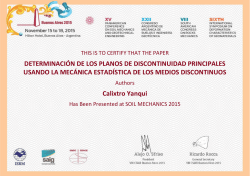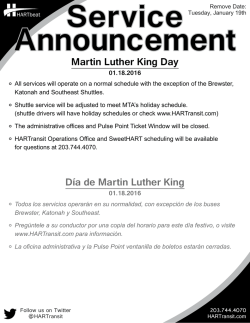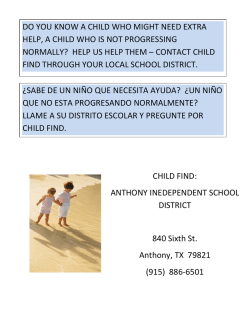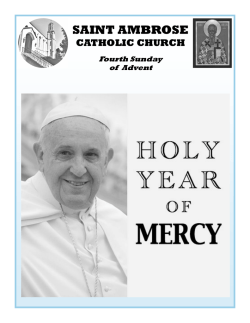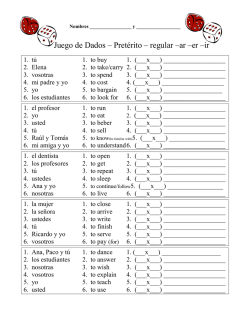
Los Reyes Magos
El Día de los Reyes Magos Cultural Activities ©H. Lamovsky, 2014 El Día de los Reyes Magos Once the New Year begins, you may consider the Christmas holiday season to be ended. In Mexico, as in the majority of Spanish-speaking countries, there is still a very important holiday left to celebrate called “El Día de los Reyes Magos” or “Three Kings Day” in English. This day is meant to commemorate the visit that the 3 Wise Men (“Los Tres Reyes Magos” in Spanish) paid to el niño Jesús after his birth. According to their religious beliefs, the Three Wise Men brought gifts of gold, frankincense, and myrrh with them. In Hispanic tradition, The Three Wise Men or Three Kings take the place of Santa Claus as the gift givers of the season. Although most Hispanic children recognize Santa Claus (“Papá Noel” in Spanish) as a symbol of the Christmas holiday, he just can’t compete with the Reyes Magos who bring children gifts each January 6th. 1 ©H. Lamovsky, 2014 Me llamo Melchor. Soy el Rey de Arabia. Yo traje oro al niño Jesús. Me llamo Baltasar. Soy el Rey de Egipto. Yo traje mirra al niño Jesús. Me llamo Gaspar. Soy el Rey de Sabá. Yo traje incienso al niño Jesús. El Día de los Reyes Magos A few days before January 6th, children will write a letter to their favorite Wise Man (or all of them). Typically, the children will comment on how their behavior was during the year, what the year was like, and what they would like as gifts – both for themselves and for the world. You are going to write your own letter, in Spanish, to one of the Reyes Magos. Use the Spanish phrases to help in the writing of your carta. ¿Quién es tu Rey favorito? He sido bueno(a) – I have been good He portado bien – I have behaved well He intentado portarme bien – I have tried to behave well Le pido… – I ask you (formal) for… Quisiera… – I would like… Paz – peace Amor - love Querido _______________, _______________________________ _______________________________ _______________________________ _______________________________ _______________________________ Melchor Baltasar Gaspar ________________________________ Firmado: 2 ©H. Lamovsky, 2014 El Día de los Reyes Magos After the letters are written, children in Mexico City (La Ciudad de México) go with their families to Parque Alameda. Alameda Park is a very old and famous park. At this time of the year, the park is filled with hundreds of stands selling food (comida), toys (juguetes), and special stationary (for the kids that have procrastinated in writing their cartas). There are also stands where children can get their pictures taken with the Tres Reyes Magos. Repaso de Vocabulario Directions: You have been introduced to several Spanish words that have to do with the celebration of Three Kings Day. Fill in the blanks with an appropriate word, in Spanish. 1. 2. 3. The most popular stands are the ones that sell beautiful balloons (globos) of every color. The children pick out their favorite globo, tie their carta to it, and let it fly away to carry their wishes to the Reyes Magos. 3 4. 5. El seis de enero es un día festivo que se llama “El Día de los ________ ________. En los países que celebran este día, los niños no reciben regalos de ________ ________. Los niños escriben _________ a los Reyes Magos para pedir________. Muchas familias van al ________ ________en los días antes del seis de enero. Aquí,se puede comprar ________de muchos colores. Los niños atan las ________ que escribieron a los ________. ©H. Lamovsky, 2014 El Día de los Reyes Magos On the evening of January 5th, the evening before “El Día de los Reyes Magos”, there are many preparations to be made. This is the night when the figures of the Reyes Magos are added to the Nativity Scenes (nacimientos) that have been set up in nearly every house in Mexico since the beginning of the Christmas season. El Nacimiento The nativity scene is an important part of the Christmas holiday season that you will learn more about in the interactive activities that follow. Some children leave milk and cookies for Melchor, Gaspar, and Baltasar. Even the animals that they travel with are left a little something as hay and buckets of water are left outside some homes. Before going to bed for the night, children leave their shoes (zapatos) in the living room (or sometimes under their beds). By morning, los Reyes Magos will leave their gifts in or near their shoes (depending on the size of the gifts). New shoes are a common gift for el Día de los Reyes Magos, so sometimes when children awake, they will find their presents near the new pair! 4 ©H. Lamovsky, 2014 El Día de los Reyes Magos As the actual Día de los Reyes Magos arrives, houses all over Mexico are full of the excitement of children who have just opened their gifts. Children will also talk about how they thought they heard the footsteps of un camello or saw a shining crown in the middle of the night. Most Mexican children do not receive the amounts of gifts that we might be accustomed to receiving. As the day begins, families are already preparing for the Merienda de Reyes which will take place later that evening. They head to the market to buy the food needed to prepare for the feast with friends and family. They are almost certain to make a stop at the local panadería to pick up a freshly made Rosca de Reyes. Families typically prepare tamales and drink chocolate before enjoying the Rosca de Reyes for dessert. 5 La Rosca de Reyes The Rosca de Reyes is a ring shaped sweetbread that is decorated with candied fruit. Somewhere in the cake, a small plastic or ceramic figure of el niño Jesús is hidden. You will learn more about this tradition in the interactive activities that follow. Each year, in Mexico City, a special Rosca de Reyes which is more than a mile long is baked especially for this day! The cake weighs almost 10 tons and it takes more than 43,000 eggs to prepare it! Tens of thousands of Mexicans gather in the zócalo to eat the humungous cake. It typically takes them only about a half hour to eat the entire thing! ©H. Lamovsky, 2014 La Rosca de Reyes As you learned previously, the Rosca de Reyes is a special kind of sweetbread made for the Día de los Reyes Magos. We also mentioned that each Rosca de Reyes has el niño Jesús hidden somewhere inside it. It may seem a bit strange, but this tradition is symbolic of the religious stories behind the holiday. As families and friends sit down to enjoy the Rosca de Reyes, each person cuts off a piece. “What if they cut off his head?”, someone always asks…well, that danger is also part of the story. First of all, the figure is hidden in the cake just as (according to the story) el niño Jesús had to be hidden so that King Herod (a king that wanted to kill him) would not find him. The knife used to cut the cake symbolizes the danger that el niño Jesús was in because of these threats from King Herod. Believe it or not, most people actually hope they don’t get the piece that hides el niño Jesús. If they do, they are responsible for hosting a celebration on February 2nd (El Día de la Candelería) and buying a new ropón for the figure of el niño Jesús used in el nacimiento. ©H. Lamovsky, 2014 You are about to eat a virtual Rosca de Reyes! Choose a piece of the Rosca de Reyes to see if YOUR piece hides el niño Jesús. If it does, perhaps you will be responsible for writing a report about El Día de la Candelería (Due on February 2nd of course)! ©H. Lamovsky, 2014 ¡No lo encontraste! Click on the Rosca de Reyes to try another piece! Since your piece of the Rosca de Reyes did not have el niño Jesús, you will not have to plan a party for el Día de la Candelería. However, you will be invited to the party thrown by the person who does find el niño Jesús. ©H. Lamovsky, 2014 ¡Lo Encontraste! You found el niño Jesús! It is now your responsibility to plan and host a party for your friends and family on el Día de la Candelería which takes place on el 2 de febrero. You will also have to buy a new ropón for el niño Jesús so that he looks nice when your family takes him to church to be blessed on that day. ©H. Lamovsky, 2014 El Nacimiento Since the nativity is representative of the story of el nacimiento del niño Jesús, each figure has a meaning and is added to the nacimiento according to the timeline of the story. Click to see the order in which the figures are added and where they are typically placed. Estrella de Belén el 14 de diciembre Los Animales el 14 de diciembre Los Pastores El 26 de diciembre El Niño Jesús la noche del 24 de diciembre María y José Cuando empieza Las Posadas (el 16 de diciembre) Los Reyes Magos y el Camello el 6 de enero ©H. Lamovsky, 2014 Actividad 1 Directions: Fill in the categories below with Spanish words or phrases that you have learned during this lesson. Make sure the words that you choose are appropriate for the category. Things to Eat and Drink Things to Do Religious Figures Places to Go ©H. Lamovsky, 2014 Actividad 2 Directions: Complete the Venn Diagram below to compare the traditions of el Día de los Reyes Magos with the traditions of Christmas as it is celebrated by some in this country. Things they have in common will go where the circles overlap, while differences will go in the outer circle. El Día de los Reyes Magos ©H. Lamovsky, 2014 La Navidad ¿Quieres Aprender Más? Here are some additional links to videos about el Día de los Reyes Magos and el Día de la Candelería if you would like to learn more! Videos 1. A video of the Three Kings Day celebration and parade in Madrid, España - https://www.youtube.com/watch?v=awvv8_BYu3o 2. The story of the Three Kings in Spanish https://www.youtube.com/watch?v=TJ_UKn0Y23M 3. Celebration of Three Kings Day in a small town in Mexico https://www.youtube.com/watch?v=RI4OumTLafs 4. News story about the mile long Rosca de Reyes https://www.youtube.com/watch?v=o2QLdoU2Z4s 5. Cute video of a boy opening his presents on Three Kings Day https://www.youtube.com/watch?v=SVnWzpepWDw 6. A video about the traditions of el Día de la Candelería https://www.youtube.com/watch?v=D0w-xVktGjg ©H. Lamovsky, 2014
© Copyright 2025
